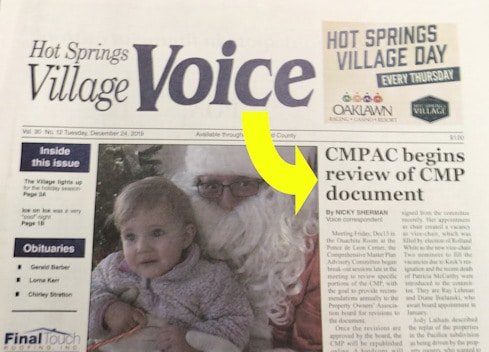Lloyd Sherman takes a few minutes to share his thoughts about the Hot Springs Village Property Owner’s Association Comprehensive Master Plan. What follows is a transcript and at the bottom of the transcript, there is a link to the video. The CMP quotes are in blue.
“Good afternoon, fellow Property Owners. This is Lloyd Sherman. I’m a candidate for the 2020 HSVPOA Board of Directors and today I’d like to discuss a topic. This will probably be one of several videos that I will try and put out between now and the time the ballots go out.”
“Today I want to talk a little bit about the Comprehensive Master Plan – CMP. I was recently at an Advisory Committee Meeting of the CMP and one of the members asked me, basically, what my issues were with the CMP.”

“We were on a break and there wasn’t going to be enough time for me to discuss my issues with the CMP so that kind of prompted me to want to do this video and give you my thoughts and my insight into what I am thinking relative to the CMP, itself.”
“I put out an article, probably several months ago now, discussing my concern with the CMP being an ideology, more than the details that are packed into the CMP.”
“It’s been almost two years since we’ve adopted the CMP and it’s been in the evolution mode a lot longer than that. Now the CMP Advisory Committee is being heard to say that it is a 30-year plan, instead of a 20-year plan.”
“Thirty years from now, most of us are not going to be too concerned about what’s going on in the Village, quite frankly. So, my concern is that we do something in the immediate future that helps the Village and I don’t see that being accomplished with the CMP.”
“The underlying problem, I think, with the CMP is that it represents a major shift in the organization. We have become a development organization and not a maintenance organization, which is what the POA should be.”
“We’re going to have more issues like we had with the Balboa Golf Course this last year. If we can’t figure out how to fund these projects, going forward, we were told when we couldn’t afford to do the Balboa Club that we have several other clubs that are going to come in behind that, to have the same problem.”
“My issue again, the detail in the CMP has to do with no substantial increase in revenues. Our salary expense continues to grow. Our infrastructure and repairs seem to continue to be a problem and aren’t getting taken care of at the rate that they need to be. Quite frankly, we are falling into a state of disrepair.”
“So, with that, I’m going to discuss a little bit, and for those of you who were here in 2010, the Board of Directors had a Strategic Plan that they put out in 2010. Very comprehensive document. This was the size of that document.” [Lloyd holds up 2010 Strategic Plan.]
“This document was signed by all of the Members of the Board of Directors. It had tasks and implementation schedules in it, down to the level of being assigned to what the General Manager and the CFO needed to do to accomplish those tasks. Very detailed. This is what a strategic plan is about. [Lloyd indicates the 2010 Strategic Plan.] This is NOT, and I repeat, NOT a strategic plan. [Lloyd indicates the CMP.] Three hundred and sixty-two pages of boilerplate information that has observations, recommendations.”
“We just last year moved this document in under a governing document. Not sure how. Not sure why. How can you have a governing document that is a work in process?”
“So, let’s discuss the first hundred pages of the CMP and talk about some of the subjects in the first hundred pages.”
“Page 10, it says:”
- ‘Master plan strategies like the recommendations you will find in this plan come from the residents that live in the community.’
“Well, I have to tell you. That is news to me because this plan was generated before the residents got a chance to look at it through the Charettes. So, problem number one.”
Page 12:
- ‘The POA Board of Directors realizes the need for a comprehensive master plan to establish recommendations and priorities on methods to generate revenue while addressing the immediate maintenance needs is now greater than ever.’
“Well, we’re two years later and we still have the same problems and they’re getting bigger. There still are no plans for revenue generation. The only plans that we had this last year for revenue generation were increases in fees and subsidies.”
“I’d also like to point out that this document was done by the Board of Directors [2010 Strategic Plan].”
“This document [Comprehensive Master Plan] was done by all of these people, ten of which are POA employees. That’s not a Board of Directors’ document.”
“This [2010 Strategic Plan] is a Board of Directors’ document.”
“To continue on, and bear with me on this, but I think it is important that we take the time to go through this because I know not everyone wants to read this much of the CMP. I want to point out why I believe that it has changed the overall direction and emphasis of the POA staff and is distracting them from the maintenance functions that need to be done.”
“I am not saying we are spending any money on other things, but we’re not focused on what needs to be focused on.”
“It says on page 13:”
- ‘The purpose of the Comprehensive Master Plan is to establish a basis for coordinating physical development decisions in order to assist in guiding the communities’ planning efforts.’ Please note the word, ‘development’.
“Page twenty [20]:”
- ‘Successful master plans are those which are community-driven.’
“I don’t think we are being really paid attention to, so I don’t know how that could be accurate.”
- ‘Planning process. The people that the plan most affect must guide the direction of any good comprehensive plan.’
“I agree with that one hundred percent. Is that being done? Don’t think so.”
Page 24:
- ‘If you are a family looking to locate to Hot Springs Village or a new retiree wishing to buy a home,’ “it goes on to say we have plenty of single-family homes.” ‘What if you want to live in a walkable neighborhood or if you prefer a smaller house with a nearby open space?’ “That is slang for pocket neighborhoods.”
“Page 36:”
- ‘Strategically a number of key land acquisitions in the coming year will help the long-term vision.’
“That one I really don’t understand because we have plenty of land. We don’t need anymore so why would we be strategically looking for key land acquisitions?”
- “Later on in that same page, thirty-six [36], it says,” ‘long-term strategy establishes a few larger and active centers with amenities and activities and a distributed network of more local and small-scale amenities at neighborhood centers’.
- ‘Adding lodging to the town center should help increase’ “as well.”
“Now, I am going to continue to bring out the town center because that is what this document, this document right here, focuses on. Later we will see that all of the objectives on how they are going increase revenues center around a town center and/or pocket neighborhoods, neither of which can be done without the approval of CCI and the easement issue being taken care of, which they tried to do through the Declarations.”
“Page 71:”
- ‘Deferred infrastructure maintenance, for example, is a significant issue that must be addressed over the long-term.’
“What about the short-term? Did we need this document to tell us that we needed to take care of our infrastructure? We can see that.”
“Page 72:”
“Here is where the Declarations came into play on the recommendations:”
- ‘Modify Article 4, Section 1 on utility easements.’
“So instead of trying to deal with the program ahead of time and figuring out what to do before we spend $500,000 on this, knowing there was an easement issue, they decided to change that process through the Declarations and it failed. Again, no transparency.”
“[Page] 74:”
- ‘Establish an amenity membership category and fee structure.’
- ‘Transfer ownership, where willing, of membership lots for POA in exchange for amenity memberships.’
- ‘Study the revenue impact of expanding amenity memberships to non-property owners.’
“This is the kind of material that is in this document, that are being considered today and people are working on.”
“Page 78:”
- ‘Integrate the occasional and sparing use of Special Assessments and Surcharges…’
- ‘Establish a communications strategy for special assessments.’
“They are coming. We just don’t know when or how.”
“Page 79:”
- ‘Consider assessment fee-based and other incentives to encourage lot development and build-out.’
“Well, again, here we go. The POA is involved in developing. We had Village Homes and Land’s total failure. We’ve have the Siega Project, which is always good to have new rooftops. But again the POA acting as a developer, instead of leaving it to the people that are actually paid to do this without being paid for with your assessment dollars.”
“Page 80:”
- ‘Recommendations on budget and finance: Development of mixed-use projects, resort hotels, and meeting venues.’
“This kind of language is scattered throughout this document and this is what is taking the attention away from the infrastructure issues and onto the development issues and it needs to stop.”
“Further down in this document, on page 80, it talks about:”
- ‘Land as collateral in joint venture partnerships with master developers.’
“So now we are going to go do something like Savannah Lakes did and get in partnership with somebody to run a hotel. What could possibly go wrong with that?”
“Page 81:”
- ‘Golf resort and conference facility.’
- ‘Mixed-use developers.’
- ‘As noted previously, the use of Special Assessments is also recommended.’
“Page 84:”
- ‘Enable and encourage development of a town center.’
- ‘Encourage development of new or more diverse housing products.’
“That could be dangerous.”
- ‘Encourage higher density housing development.’
“Page 89 (just a couple of quick ones):”
- ‘The town center and other new development concepts are proposed as part of this plan.’
“In the first hundred pages…here’s another one on page 91:”
- ‘Establish a town center.’
“I am all for strategic planning. I am not for planning something 30 years from now, which cannot be achieved in a document like this. This is unwieldy. It’s not controllable. The CMP Advisory Committee has done nothing that I’m aware of. They haven’t reported to the Board. The Board hasn’t been involved in any of the discussions on where the CMP is at this point. They haven’t given them a briefing.”
“What has the CMP done for us the last two years, other than drain our resources away from being a maintenance organization?”
“As I said, I am all for strategy plans – one, three, and five-year strategy plans, with an eye on the future. You can’t take your eye off of the future. But you have to focus on today and what can be done and what’s realistic. This is not realistic. [CMP] This was realistic. [2010 Strategic Plan]”
“I intend to introduce concepts like this back into the Board and into the working sessions if I am elected.”
“I am asking for your support and your vote in this next election. I also want to mention that I am also endorsing Dick Garrison and Tucker Omohundro as the other two candidates to take the seats with me. They are like-minded and I believe will be assets to our next Board. Thank you and I will see you on my next video.”












Frank Shears aka Bubba
12/28/2019 — 12:39 pm
Excellent.
Thank you Lloyd for recording the video and thank you Cheryl and Joe for publishing this very informative article and video.
Mary Odom
12/28/2019 — 12:40 pm
Thank you Lloyd…we voted for you last time and we certainly will again right along with Dick and Tucker!
Dave Sintich
12/28/2019 — 1:40 pm
This seems to be nothing more than a money grab from the residents now, for the residents in the future, if it’s still in existence. Planning future ideas without the developers permission and an attempt to oust his interests. All of the items listed are just their outline to get more money from us, to pad their pockets with pay raises and useless business trips for the people that should be here DOING their jobs. In 20 or thirty years who now cares for a “community center” that probably will never happen as the powers to be NOW are spending every penny available. Mr. Sherman points out many flaws in the cmp which would cause the death of HSV unless we elect people with logic and knowledge in the fields of creating a successful business plan and intelligently carrying it out with COMMON SENSE. I believe he and our other two gentleman running can do this and do it in a competent way.
Demolition by neglect
12/28/2019 — 1:41 pm
Obsolescence by design!
Plainly said, if todays amenities are decaying and in disrepair is it by design of POA leaders? For what purpose? Special assessments in our future? Increased fees for all the amenities we moved here to enjoy? Loss freedom?
We moved here to get away from excess taxes, political issues that divide us, crime, and traffic.
We also moved here because it was viewed to be affordable, and to enjoy the quiet serenity and amenities of the Village.
In the forty plus years we have been visiting HSV we viewed the POA as a maintenance organization guided by the needs and wants of resident members.
There is cause for change, and we hope that new leaders emerge to right the ship.
OBTW … the direction of the CMP will only benefit unknown developers because we home owners will be held responsible for the cost, which will be 10 greater than the expenses to date which is probably in excess of $1,000,000.
Suzanne
12/28/2019 — 1:43 pm
Thank you for your assessment. You will get my vote.
You have landed on some key issues with the CMP, and there are many. I’m not quite what the thought process was before it was presented but it was something along the lines of a corporation “dishing “ a new plan to employees. We are not employees though, beholding our position to a boss. Also, I believe they counted on the fact that retirees would be so busy with their personal endeavors and interests that they wouldn’t notice OR get involved. That was a major miscalculation.
I read the CMP in total three times. After the first read through I thought perhaps I had missed something or misunderstood. The second and third read through only confirmed my assessment that “the emperor has no clothes”. I could not imagine that the firm which produced this boilerplate, as Lloyd referred to it, had ever physically stepped foot inside the Village.
It’s true that if the Village is not growing it’s dying, but if it’s not maintaining it’s also dying. Some creative thinking must be applied to develop new revenue streams, not rely heavily on assessments. There’s a glut of people retiring, why aren’t we attracting them. The people I’ve talked to who have recently moved here found it on their own not due to any marketing efforts by the POA. I hear people say they don’t want the Village to be discovered. Well then without additional rooftops you’re going to have to pay more – that’s the reality.
Lloyd you have hit the nail on the head on so many problems but this is just the tip of a very unwieldy iceberg.
George Koziol
12/28/2019 — 4:00 pm
It is wrong! You are correct, we have to take better care of what we have. I have in other comments before mentioned that I have seen this type of management before. Not once or twice but three times. Twice almost ending the entity that dove right into it without thinking. The third end in bankruptcy. The other two were permanently crippled. That is where this goes, if we don’t change or stop this we will be one or the other
Minn Daly
12/28/2019 — 5:57 pm
Great work Lloyd! You will have my vote along with Tucker & Dick. We need BOD members with common sense, as well as intellect & business operations. Your video certainly showed the faults in CMP planning & current operations that are destroying our community. Again you will have my support! Minn Daly
Linda Anderson
12/28/2019 — 9:24 pm
THANK YOU LLOYD. As it turned out LN sold our community on a faulty plan, then turned it into a governing document with intent to attach all other non-Board Committee’s to it. Unfortunately, the CMP Advisory Committee with a justice of the peace , lawyer, and other well-intentioned committee members ran around in circles trying to figure out the CMP and make it work. Recently, the Justice of the peace resigned. The Board/CEO are still convinced the CMP is their choice for the future of HSV even if they have to cut it up and glue it back together. If this is what SUCCESS looks like, then HSV is in big trouble.
Linda Anderson observer
12/30/2019 — 7:44 am
What are your ideas on a bright future for HSV?
You guys “tear down” by firing shots at others.
You don’t build anything. If you spent as much time coming up with ideas as you do criticizing other you might be a worthy spokesman. So just keep complaining. See where/what that gets you
Phil Lemler
12/30/2019 — 10:29 am
I believe Linda Anderson tried to become an active participant (to offer some of her good ideas) by joining the “Governance Committee”. However, she was declined because she actually had “good ideas” that the POA did not want to hear. So, the POA continues to advertise for Governance Committee members but won’t accept any that disagree with the gestapo! No wonder nothing positive is getting done!
Anonymous
12/31/2019 — 7:43 am
What were those good ideas and fresh solutions? See if you can repeat it without saying what it is you are against.
Anonymous
12/30/2019 — 11:03 pm
The ceo’s cmp is nothing but a teardown: Original guardhouse and Tall pines at Front Park, millions of the best timber from our 26,000 acres, Front Fountain, 2 full basketball courts and three tennis courts, Fay Jones DeSoto Club interior, DeSoto Pool and Bathhouse, Historic stone bridge between DeSoto Pool and DeSoto Family Park, Balboa Beach, Cortez Beach, HSV Logo, ByLaws, Declarations, POA employee benefits, innocent property owners property rights and freedoms, relationship with CCI, the teardown is unending.
George
12/28/2019 — 9:45 pm
If this is the best candidate pool we have, we are doomed. Surely there is someone with a business mind out there. Softball Sherman is a no vote for me.
Phil Lemler
12/29/2019 — 7:56 am
George – … why do you call Lloyd “softball Sherman”? Lloyd is standing up and speaking out against the problems facing HSV and offering solutions. This is in direct comparison to Weiss, Cunningham, Leurhing, Erickson, Medica and Dixon who probably have never read the CMP … in its entirety … or to the degree Lloyd has … the existing/past board could not have read it … it is the only excuse for them supporting it that exists … because IF they had read it … and still supported it … their XXX would be in question!
Anonymous
12/30/2019 — 7:59 am
How are things in Arizona
Phil Lemler
12/30/2019 — 10:13 am
Wonderful! Thanks for asking … you must really like me.
Anonymous
12/30/2019 — 8:03 am
Phil’ back
Voting for Lloyd Sherman BOD
12/30/2019 — 9:54 am
If this is the best we can do for a CEO, we are doomed. Surely there is a manager with a business mind out there. HSV needs board members like Lloyd to protect property owner interests.
Dan Leathers
12/28/2019 — 10:00 pm
362 pages for $500,000. $1,381.21 per page.
Anonymous
12/28/2019 — 11:12 pm
And another $20,000 per page to implement it… and that is only in less than 2 years… with ZERO results.
Andy Kramek
12/29/2019 — 10:23 am
Actually, 60 of the pages were “Intentionally left blank” so it is only 301 pages at $1661.12 per page!
George
12/28/2019 — 10:02 pm
“Marketing the Village to stimulate growth has been absent for an extended period of time.” Lloyd Sherman
Sherman should decide whether he believes in growth or maintenance.
Anonymous
12/28/2019 — 11:23 pm
Can you have growth without maintenance George? Where is your dodgeball business mind?
Phil Lemler
12/29/2019 — 7:39 am
Hey George … the economic reality is that you must have growth and maintenance. Lloyd’s point is that the CMP does neither. It is a plan generated by inexperience, supported by ignorance and promoted by those blind to reality.
Fortunately, Lloyd and Dick have the experience and vision to see an HSV pathway forward that is not based in the soul of the unimplementable CMP!
Good job Lloyd!
Anonymous
12/30/2019 — 8:22 am
Do you know the definition of “consultant”?Many define it as “unemployed”.
Consultants are people that have been fired or otherwise become unemployable. They then sell their ideas that landed them a self appointed consulting job.
Phil Lemler
12/30/2019 — 10:15 am
Mr./Ms. Anonymous – is this “definition of consultant” comment directed to me? Phil Lemler?
William
12/30/2019 — 8:07 am
Lloyd has put together a description of “what wrong”. I look forward to hearing about his “growth plan”
Anonymous
12/31/2019 — 7:59 am
So far nothing but the same old babbling from we the puppets. Who is being paid this time for “consulting”?
Kirk Denger
12/28/2019 — 10:40 pm
Thank you, Lloyd, again for stating the obvious CLEARLY as your candidate platform. None of us want to be subservient to a MASTER from Communist Cuba as is where the DPZ/CMP software program originates. A simple 4/3 majority Board vote will end this cmp insanity.
Julie
12/29/2019 — 4:45 am
I have been telling you people for a long time now that this plan will NEVER EVER work in HSV and nothing has changed to make that any less true.
There is simply no money available for any of the plan’s ideas. None. Primarily due to the wanton waste of what little money we did have being used to purchase this boilerplates joke.
Additionally you have the wanton waste from such idiotic things as the failed Troon contract, the failed gate contract, the failed HVAC mess at the indoor pool, the destruction of a perfectly good outdoor pool, the neglect of our roads, sewers, and culverts, the failed dredging, the failed everything the POA has tried to do in the last several years.
Not only is there no money, there is no one wanting the plan. No resident wants low-cost, high-density housing. No resident wants a town center. We already have two of them and they are run-down, abject failures. No resort hotel is ever going to be built in HSV. EVER. No resident wants an outlying pocket neighborhood with little pathways to nowhere. No resident wants a silly, pathetically ill-informed committee to make any decisions regarding the failed CMP. No resident wants to continue to pay higher and higher fees for things that are deteriorating each and every year. The numbers don’t lie. Participation in everything is down. Endless cycle. Raise fees, get less revenue. Do it again and again. Attempt to get people not to notice by planning for wireless water meters while you can’t even maintain the infrastructure you have.
I could go on and on about the far-reaching and voluminous bone-headed decisions this board and the POA continue to make. But what is the point?
Now we are told, once again, that the next election will solve all our problems. How many times have we heard that? It won’t. It never has. Not once. Ever.
Wake up peoples. It is all a sad, sad joke. But nothing is changing. It is only getting worse. Far, far worse.
Look around and see if we are truly “livin’ the dream”. I think not.
Andy Kramek
12/29/2019 — 8:29 am
Your point that “silly, pathetically ill-informed committee to make any decisions regarding the failed CMP” is particularly valid. As I have pointed out elsewhere the so-called Advisory Committee (CMPAC) has not even tackled the first step defined in their own ridiculous document – which was supposed to be to identify and prioritize the needs of the Village.
Instead we have SWOT analyses (oh, hang on, they didn’t have time to do that last time around did they) and discussions about the definition of words in the “Governing Document”. Oh and of course don’t forget this little gem from the last meeting while discussing the Coronado Centre:
Heau: “I was kind of thinking in terms of, we were trying to find a project to be subject to a project management process and I was just wondering if that was a possible candidate.”
They are KIND OF THINKING about TRYING to find a project that can be “subject to a project management process” – seriously? What kind of idiocy is this? Are we to understand that current projects are NOT subject to a project management process? Based on the results of previous projects I would have to agree with that given, as Julie points out,
“the failed Troon contract, the failed gate contract, the failed HVAC mess at the indoor pool, the destruction of a perfectly good outdoor pool, the neglect of our roads, sewers, and culverts, the failed dredging, the failed everything the POA has tried to do in the last several years.”
If this wasn’t so serious it would be funny. I totally agree with Julie that unless people wake up, and real soon, it is only going to get worse.
Lloyd Sherman
12/29/2019 — 8:41 am
One of the reasons I don’t post over on ND is that comments become attacks and in most cases, the subject never stays on the point raised in the post. I am happy that doesn’t happen over here, but I also can’t and won’t ignore the opinions brought up by “George”. At least it wasn’t anonymous. However, George, you should first know that I have a significant business background, mostly in General Manager capacities. Then I took those experiences and put them to work doing business consulting services through my own firm for the last 12 years of my active working career. I can walk and chew gum at the same time and any knowledgable business person knows you have to take care of what you have while you are growing the business. Doing one without the other is a self-defeating process. “Softballs”? Really? If you had read any of my previous writings you would know I don’t deal in softballs. I also don’t sweep items under the rug. The only way you can solve a problem is by attacking it straight on. The CMP as it currently stands is not implementable in this environment and it needs to be scrapped. In its place needs to come a BOARD LEVEL strategic plan much like the one done in 2010 and focus on the immediate future with an eye on the future; not the other way around. I don’t expect everyone to agree with me and everyone is entitled to their own opinions, but not their own facts. I deal in facts and reality. With me on the board you get both facts and reality.
George
12/29/2019 — 3:34 pm
Fair enough, Lloyd, then tell us YOUR plan for “growth” and “revenue generation”. Maintenance is spending on what you believe are the priorities. We know what you don’t support, what maintenance can we expect you to support spending more on?
In your research, did you notice that the 2010 plan called for a master plan?
Anonymous
12/29/2019 — 10:56 am
George is a Lesley and legacy BOD support, if not, a pawn. He has no original thought and is threatened by informed Villagers like Lloyd.
If George was half the man that Lloyd is, he’d step up and run for a BOD seat. Then we could all let him know what we think!
Lloyd – Tucker – Dick in 2020! The best choice for real Villagers.
Anonymous
12/30/2019 — 7:57 am
Well said.
Lloyd aka Lloyd
12/29/2019 — 4:56 pm
Hello again George; if that in fact is your real name. I’m not going to use this forum as a personal exchange medium for you and me and I encourage you to reach out to me via my email address if you want to dialogue further. My position on revenue generation has been posted on several occasions. The board’s job is to develop the strategy and provide guidance to the people who we actually pay to get the job done. We have a marketing problem and have had for years and the CMP does nothing to help us fix that problem. In fact, it does quite the opposite and tries to change the Village from what it has been with zero chance of being what these overpaid consultants say it should be. It is simply not manageable and certainly doesn’t have answers that get us where we need to get in the immediate future. I am fully aware of the 2010 Plan and simply because it addresses plans doesn’t automatically indicate the CMP was the answer. Thank you for your interest in my opinions.
George
12/31/2019 — 6:38 am
You promised transparency so we expect you to be able to state your opinions in any forum. You have no problem doing it on closed Facebook pages. What is your plan for growth and what do you consider to be maintenance priorities?
Stay Involved!
12/29/2019 — 5:41 pm
Lloyd has hit on a number of valid points about the absurdity of the CMP and now a legal Village document. Additionally, the Advisory Committee is equally flawed and has absolutely no idea what is supposed their end product.
Others have also added questions and folly to both the Document and the Committee ,which all have validity to them. But the best, most accurate and truthful statements made by all are the fact that if HSV does not change the way it is being governed and run, it will not survive another decade. And I agree we have three businessmen candidates, Dick, Lloyd, and Tucker, who with Diana, can begin to straighten out the mess we are now engulfed in.
But, I want to warn everyone that the power still lies with the CEO and BOD. And it is not beyond their unethical thinking to prevent at least 2 of the 4 above mentioned Villagers to be prevented from future involvement in POA business.
If any shenanigans do occur we MUST rebel.
Anonymous
12/29/2019 — 10:08 pm
Lloyd you have 13 votes For your candidacy on this one video so far.
Anonymous
12/30/2019 — 7:58 am
How many “against”
Nancy
12/30/2019 — 7:28 am
This statement needs more explanation:
“That could be dangerous.”
Context:
‘Enable and encourage development of a town center.’
‘Encourage development of new or more diverse housing products.’
“That could be dangerous.”
Anonymous
12/30/2019 — 8:02 am
Lloyd you are the best. Keep it coming
Anonymous
12/30/2019 — 10:04 am
I took it to mean trailer park type homes as being dangerous. Perhaps I missed the point.
HSVP C
12/30/2019 — 7:57 am
Nancy, putting 3 homes on one existing lot could be dangerous to property values in the surrounding areas. – Cheryl
Anonymous
12/30/2019 — 8:16 am
Who is Linda Anderson
Anonymous
12/31/2019 — 8:16 am
A We the Puppets “consultant”
Lloyd Sherman
12/30/2019 — 10:55 am
The use of the term “dangerous” in the context of this video was directed at how decisions can impact property values and given this is a huge concern of many in the Village, any decision to change the existing housing mix could be detrimental to housing values. For instance the introduction of a concept like trailer homes in the Village (which I have heard people suggest); or getting HUD or HOPE grants for low-income housing; or Section 8 housing vouchers; or allowing the rental market to exceed a reasonable number (which we currently don’t even know what that number should be). I could probably go on, but any activity that can create a negative impact on the housing market needs serious investigation and vetting and yes could be dangerous to housing values.
John Sowers
01/02/2020 — 12:08 am
Lloyd,
I want to go into much more than the CMP, so please answer my questions.
Our HSV POA infrastructure and home assets total over 1.2 billion dollars, or 1200 million dollars. We spent .5 million dollars for a Comprehensive Master Plan to help move us prudently into the future and sustain and protect the value of our infrastructure and homes. That works out to about $17 for every resident and non-resident who has invested in HSV. How much do you pay to insure your home every year?
Didn’t the POA staff activity that promoted using POA owned lots for new home construction always allow and encourage all HSV real estate agents to market and sell these homes and lots?
We now have a shortage of available HSV homes for sale, which means a sellers’ market to me. That means that homes that are well maintained and at good locations are selling quickly. That is the case on the east end of HSV. So should we (the POA) presently spend any large amounts of marketing $ if we have a shortage of homes for sale? And it is a fact that the best marketers are HSV residents who live here.
Do you think the negative VV letters to the editor, and the negative comments in the Next Door blog, about the POA board members and CEO adversely affect those that might consider buying homes in HSV?
What is your estimate of the number of people that should reside in HSV, considering infrastructure, safety, and security limitations?
The HSV real estate industry probably generates about $6 million in commissions each year. What is your estimate of the net income (sales commissions minus expenses)? You are a real estate agent; what have been your total sales, commissions, and expenses over each of the past five years.
Our assessment fees are too low; what should those fees be for residents and non-resident property owners?
And do you serve on any POA volunteer committees, and if not, why not?
Thanks from John Sowers, JCSowers2@msn.com; 501-226-3039, volunteer POA Public Services Committee member.
Tom Blakeman
01/02/2020 — 6:33 pm
John,
Many thanks for your contributions on the Public Services Committee. That said, the answers to all your questions are addressed in ‘A New Plan’ written by me. You know where to find it. Where is your detailed plan?
HSVP C
01/02/2020 — 6:46 pm
Here is a link to the New Plan: https://hotspringsvillagepeople.com/a-new-plan-for-hsvpoa/
Anonymous
01/04/2020 — 10:35 am
John, I am not LLoyd, but I would like to add to your perspective. Your HSVPOA assets estimate is not even 1/2 of the replacement value of HSVPOA assets. How much is your home insurance? Depending on your coverage, it is proportional and about the same as your property taxes. Home insurance and property taxes are proportional to property value. Would it be prudent to pay 1/2 price for your home insurance if you knew that it would only cover 1/2 of the replacement value of your home? Or is it prudent to pay double price for your home insurance knowing that it will not pay double the replacement value?
Is it prudent to promote an unvetted and equally unbalanced plan that will not fit within easements through a positive charade scheme? The word Master in the Comprehensive Master Plan connotates the master-slave relationship. It also illustrates the methods used by masters to take their slaves by trap and then by force.
Lloyd Sherman
01/02/2020 — 1:10 pm
Just for the record, I responded to John Sower’s questions as noted above although several I thought were personal in nature. Anyone at any time can reach out to me and ask questions of me via PM or email. I will always respond. I only ask that you not share any of my responses without my permission. My email address is lesherman1948@gmail.com and yes that gives away my age.
Janice M Zielke
05/15/2020 — 4:51 pm
I would like to suggest an idea to market our beautiful village.
Many residents have extra lots that where purchased with plans to build, but for many reasons bought homes instead of building.
I was reading about many states that offer free land to get people to move to their states.
I suggest the village offer home owners the option to offer their lots for free to peop!e that build a home on the lot within two years.
The home owners would then be given an exemption from having to pay the monthly POA fees for two years on their current home
The village can then market free lots with lateral to qualified buyers.
Advertise in retirement magazines and on the website.
That’s what got my attention when reading a magazine.
John Sowers
05/17/2020 — 9:39 am
Here we are in May 2020 and below are my (John Sowers) questions and Lloyd Sherman’s answers back in January 2020.
I want to go into much more than the CMP, so please answer my questions.
Question: Our HSV POA infrastructure and home assets total over 1.2 billion dollars, or 1200 million dollars. We spent .5 million dollars for a Comprehensive Master Plan to help move us prudently into the future and sustain and protect the value of our infrastructure and homes. That works out to about $17 for every resident and non-resident who has invested in HSV. How much do you pay to insure your home every year?
Response: How much I pay for something is my concern, not yours! The CMP doesn’t prudently move us anywhere. In fact, it is built entirely on having a Town Center, Multi-Use Housing, and Lodging. ALL of these items are projects for Developers; not for a maintenance organization. Even the CMP didn’t answer the question of how we were going to resolve our growing issue. Even after their then 20 year plan, it doesn’t show us breaking even but continuing to go in the hole. LLOYD, THE CMP IS A PLAN TO HELP PROTECT OUR HSV INFRASTRUCTURE AND HOME ASSETS, JUST LIKE YOU AND I HAVE AN INSURANCE PLAN TO PROTECT OUR HOMES
Question: Didn’t the POA staff activity that promoted using POA owned lots for new home construction always allow and encourage all HSV real estate agents to market and sell these homes and lots?
Response: In basic answer to your question, NO. We have a glut of lots. What we don’t have is buyers of lots or new houses. Any lot activity our firm has gotten has ALL been from the previously pushed NRP lots that people want to sell. When they find out their $30-40K investment is now worth no more than $3K, they become very angry. The POA has never taken an active role in promoting lot sales since the NRP fiasco. LLOYD, YES THE POA STAFF DID ALLOW ALL HSV REAL ESTATE PERSONNEL TO SELL POA LOTS AND HOMES BUILT ON THOSE LOTS. AND WHY ARE HSV LOT INVESTORS UNHAPPY BECAUSE THEIR $30-40K INVESTMENT IN LOTS IS NOW ONLY WORTH LESS THAN $3K? MAYBE ONE OF THE NEW POA BOARD MEMBERS CAN HELP ANSWER THAT.
Question: We now have a shortage of available HSV homes for sale, which means a sellers’ market to me. That means that homes that are well maintained and at good locations are selling quickly. That is the case on the east end of HSV. So should we (the POA) presently spend any large amounts of marketing $ if we have a shortage of homes for sale? And it is a fact that the best marketers are HSV residents who live here.
Response: Yes, we should spend marketing dollars on those who will come here and build. We are going into debt at about $7 million a year right now in deferred maintenance. If that trend continues, we won’t be attracting new. Without new growth, the Village will eventually fail. LLOYD, PLEASE BRING YOUR DETAILS OF THE $7 MILLION YEARLY DEFERRED MAINTENANCE, REPAIR, ALTERATION ANNUAL SHORTFALLS TO THE VOLUNTEER PUBLIC SERVICES MEETINGS.
Question: Do you think the negative VV letters to the editor, and the negative comments in the Next Door blog, about the POA board members and CEO adversely affect those that might consider buying homes in HSV?
Response: While this is a main talking point for Ms. Nalley, I personally have not seen any such data or even run into anyone who hasn’t moved here because of the press. I have seen quite the opposite with people leaving because of what is going on and that should concern you more. LLOYD, AGAIN DO YOU THINK THE NEGATIVE VV LETTERS TO THE EDITOR,AND THE NEGATIVE COMMENT ON THE NEXT DOOR BLOG, ABOUT THE POA BOARD MEMBERS AND CEO ADVERSELY AFFECTS THOSE THAT MIGHT CONSIDER BUYING HOMES IN HSV. DATA? SEEN WHERE? HEARSAY?
Question: What is your estimate of the number of people that should reside in HSV, considering infrastructure, safety, and security limitations?
Response: Giving you a number would be useless but I believe if we had 2,500 more rooftops, we could afford the existing infrastructure. However, that assumes we keep spending at the rate we are now and I believe that number must be scaled back. LLOYD, IF WE DON’T ESTIMATE HOW MANY PEOPLE SHOULD EVENTUALLY LIVE IN HSV, WE WON’T BE ABLE TO PLAN TO (REPEAT PLAN TO) MAINTAIN, REPAIR, AND ALTER OUR INFRASTRUCTURE ASSETS. SOME WANT NO GROWTH, MOST ARE SAYING AT AROUND 18000, THAT WOULD MEAN ABOUT 1750 NEW HOUSETOPS (18000-14500, DIVIDED BY 2)
Question: The HSV real estate industry probably generates about $6 million in commissions each year. What is your estimate of the net income (sales commissions minus expenses)? You are a real estate agent; what have been your total sales, commissions, and expenses over each of the past five years.
Response: Again I am unsure how any of that is your business and I have no intention of sharing my private information with you. What I can tell you is that there are currently 110 agents in the HSV Board of Realtors. We sold 610 units this last year which means the average agents sells 5.5 units, 1 condo and 1 lot. I work at this PT and meet or exceed those numbers. LLOYD, DO THE 610 UNITS INCLUDE ONLY HOMES (110 TIMES 5.5 EQUALS 605)? DOES IT INCLUDE CONDO UNITS (110 TIMES 6.5 EQUALS 715)? DOES IT INCLUDE LOTS (110 TIMES 7.5 EQUALS 825)?
Question: Our assessment fees are too low; what should those fees be for residents and non-resident property owners?
Response: This may be one of the few things we agree on. However, I also know that there is currently no appetite for giving the POA more money as too many believe we are misdirecting funds and not spending wisely. I am among them. The two-tier debacle ensured that non-resident property owners would not approve an increase that included them. They outnumber us. The two-tier has also set up an environment where our bad debt now equals what we received in assessments from that program.
If elected I believe you will find that I operate from a standpoint of logic, reason and common sense. I am currently running for the board and you will hear me say things that are much more vocal than I would be on the board. LLOYD. THE NON RESIDENCE PROPERY OWNERS HAVE PAID MORE IN ASSESSMENTS THAN THE RESIDENT PROPERTY OWNERS, AND MOST DON’T LIVE IN OR NEAR HSV, AND MOST DON’T USE OUR INFRASTRUCTURE ASSETS AND AMENITIES. THE TWO TIER WAS NOT A DEBACLE AND NOW YOU AGREE OUR ASSESSMENTS ARE TOO LOW.
Question: And do you serve on any POA volunteer committees, and if not, why not?
Response: This is one of your gotcha questions. First, I don’t serve on any committees because for the most part it is an exercise in futility. The POA has proven time and time again that they don’t use the work of committees. I know that is not 100% true, but is is prevalent. The second and more important is that I serve on the Real Estate Board and on the Evening Lions Board and between those activities I have plenty I can be doing for the community instead of wasting my breath. LLOYD. YES THE POA BOARD DOES USE THE WORK OF COMMITTEES. SINCE YOU DON’T SERVE ON ANY, HOW DO YOU KNOW, JUST HEARSAY?
Thanks from John Sowers, JCSowers2@msn.com; 501-226-3039, volunteer POA Public Services Committee member.
HSVP C
05/17/2020 — 12:42 pm
Mr. Sowers, you never cease to amaze me.
John Sowers
05/17/2020 — 1:53 pm
Cheryl. Thanks